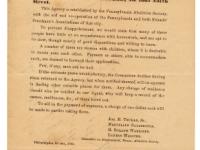Students analyze a 19th century advertisement and the records of the PAS’s Committee of Employment to understand the type of labor available to the black population in the post-Civil War period.
Emancipation and PAS Support of Philadelphia’s Free Black Labor Force
Home ›
Education ›
Unit Plans ›
The Pennsylvania Abolition Society and the Free Black Community ›
Emancipation and PAS Support of Philadelphia’s Free Black Labor Force
Emancipation and PAS Support of Philadelphia’s Free Black Labor Force
Essential Questions
What role does analysis have in historical construction?
Why is time and space important to the study of history?
Objectives
- Students will be able to identify the types of employment opportunities that were available to the Philadelphia’s black community during and after the American Civil War by analyzing primary source documents related to employment.
- Students will be able to understand the role the Pennsylvania Abolition Society played the free black community by studying the organization’s assistance with finding employment.
- Students will be able to infer the challenges the free black community faced while obtaining or engaging in labor by analyzing primary source material.
Primary Sources
Other Materials
Suggested Instructional Procedures
- Have students brainstorm the types of jobs that former slaves arriving in Philadelphia might have engaged in after the Civil War. Students should consider the kinds of skills former slaves might have had as well as the types of jobs available in Philadelphia in the mid-19th century. Discuss the rise of manufacturing centers and the reliance on unskilled labor.
- Distribute the “Committee on Employment” document. Working in pairs, have students consider the types of jobs listed and the types of skills needed to perform those jobs. As a class, discuss the prevalence of unskilled, domestic positions. Ask students to respond to the types of jobs that they would have expected to see listed but are not. Students should note the absence of industrial positions that would have required unskilled labor. Ask students to speculate why those jobs are absent from the list.
- Distribute the Employment Circular. Have students read through and think about how the information provided in the Circular compares to the requests presented in the “Committee on Employment” document. Students should pay particular attention to the statement in the Circular regarding the lack of housework experience of the newly arriving labor force. Ask students to think about how the labor requests reflect assumptions that employers in Philadelphia made about the newly arriving southern black population. What do these labor requests reveal about the types of jobs free blacks already living in Philadelphia held?
- Drawing together evidence from both documents, have students develop a statement regarding the type of labor newly freed persons engaged in and why they might have been limited to these specific jobs. Responses may include assumptions employers made regarding the kinds of skills newly freed blacks had and the role that discrimination played in shaping the work experiences of black labor in Philadelphia as indicated by the lack of industrial positions. Teachers might make a comparison to immigrant groups such as the Irish, a largely rural people who arrived with little skills, but readily filled industrial positions.
- Conclude with a discussion about the role of the PAS in this post-war period. What type of assistance did this organization provide? Discuss the role of the PAS as a labor agent for the newly freed population.
Vocabulary
Manufacturing: to make something on a large scale using machinery
Skilled labor: labor that requires special training for its satisfactory performance
Unskilled labor: work that requires practically no training or experience
Plans in this Unit
Grade Level
Middle School
High School
Duration
One class period
Standards/Eligible Content
8.1.U.A
8.1.U.B
8.1.U.C
CC.8.5.9-10.A
About the Author
This unit was created by Kim Gallon. Updated for SAS by Danielle J. Gross, Education Intern, Historical Society of Pennsylvania.
Attention Teachers!
Let us know how you used this plan and be featured on our site! Submit your story here.

